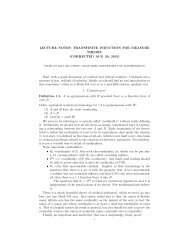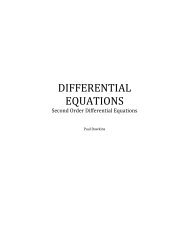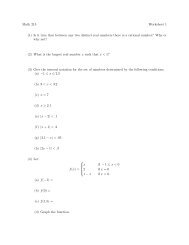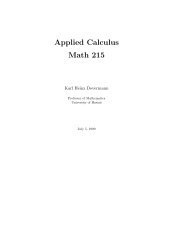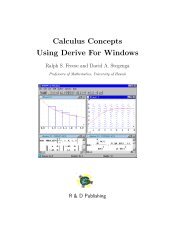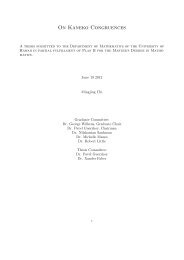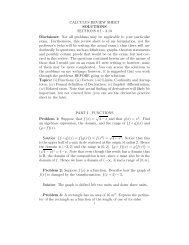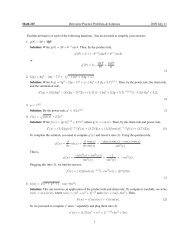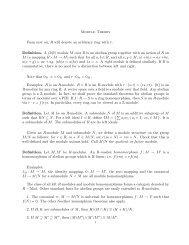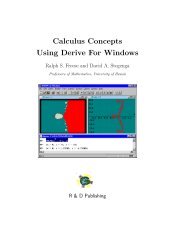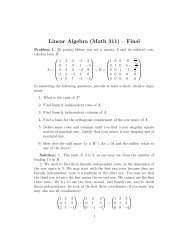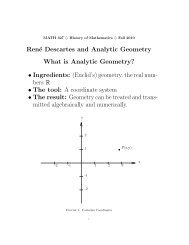Problems and Solutions in - Mathematics - University of Hawaii
Problems and Solutions in - Mathematics - University of Hawaii
Problems and Solutions in - Mathematics - University of Hawaii
You also want an ePaper? Increase the reach of your titles
YUMPU automatically turns print PDFs into web optimized ePapers that Google loves.
1.1 1991 November 21 1 REAL ANALYSIS<br />
Solution: For n = 1, 2, . . ., def<strong>in</strong>e<br />
Clearly,<br />
<strong>and</strong> each An is measurable (why?). 3 Next, def<strong>in</strong>e<br />
An = {x ∈ X : 1/n ≤ |f(x)| < n}.<br />
A1 ⊆ A2 ⊆ · · · ↑ A <br />
∞<br />
n=1<br />
A0 = {x ∈ X : f(x) = 0} <strong>and</strong> A∞ = {x ∈ X : |f(x)| = ∞}.<br />
Then X = A0 ∪ A ∪ A∞ is a disjo<strong>in</strong>t union, <strong>and</strong><br />
<br />
|f| = |f| +<br />
X<br />
A0<br />
A<br />
<br />
|f| +<br />
A∞<br />
An<br />
<br />
|f| =<br />
A<br />
|f|. (2)<br />
The first term <strong>in</strong> the middle expression is zero s<strong>in</strong>ce f is zero on A0, <strong>and</strong> the third term is zero s<strong>in</strong>ce f ∈ L1 (µ)<br />
implies µ(A∞) = 0. To prove the result, then, we must f<strong>in</strong>d a measurable set E such that <br />
|f| < ɛ, <strong>and</strong><br />
A\E<br />
µ(E) < ∞.<br />
Def<strong>in</strong>e fn = |f|χAn . Then {fn} is a sequence <strong>of</strong> non-negative measurable functions <strong>and</strong>, for each x ∈ X,<br />
limn→∞ fn(x) = |f(x)|χA(x). S<strong>in</strong>ce An ⊆ An+1, we have 0 ≤ f1(x) ≤ f2(x) ≤ · · · , so the monotone<br />
convergence theorem4 implies <br />
X fn → <br />
|f|, <strong>and</strong>, by (2),<br />
A<br />
<br />
<br />
lim<br />
n→∞<br />
An<br />
Therefore, there is some N > 0 for which <br />
F<strong>in</strong>ally, note that 1/N ≤ |f| < N on AN, so<br />
<br />
µ(AN) ≤ N<br />
|f| dµ =<br />
X\AN<br />
AN<br />
A<br />
|f| dµ =<br />
|f| dµ < ɛ.<br />
<br />
|f| dµ ≤ N<br />
X<br />
X<br />
|f| dµ.<br />
|f| dµ < ∞.<br />
Therefore, the set E = AN meets the given criteria. ⊓⊔<br />
4. 5 If (X, Σ, µ) is a measure space, f is a non-negative measurable function, <strong>and</strong> ν(E) = <br />
measure.<br />
E<br />
f dµ, show that ν is a<br />
Solution: Clearly µ(E) = 0 ⇒ ν(E) = 0. Therefore, ν(∅) = µ(∅) = 0. In particular ν is not identically <strong>in</strong>f<strong>in</strong>ity,<br />
so we need only check countable additivity. Let {E1, E2, . . .} be a countable collection <strong>of</strong> disjo<strong>in</strong>t measurable sets.<br />
3 Answer: f is measurable <strong>and</strong> x → |x| is cont<strong>in</strong>uous, so g = |f| is measurable. Therefore, An = g −1 ([1/n, n)) is measurable (theorem A.2).<br />
4 Alternatively, we could have cited the dom<strong>in</strong>ated convergence theorem here s<strong>in</strong>ce fn(x) ≤ |f(x)| (x ∈ X; n = 1, 2, . . .).<br />
5 See also: Rud<strong>in</strong> [8], chapter 1. Thanks to Matt Chasse for po<strong>in</strong>t<strong>in</strong>g out a mistake <strong>in</strong> my orig<strong>in</strong>al solution to this problem. I believe the solution<br />
given here is correct, but the skeptical reader is encouraged to consult Rud<strong>in</strong>.<br />
4




